No matter how much you invest in marketing and how good your messaging is, nothing you say will ever be as convincing to prospective customers as hearing from happy customers themselves.
People know that friends and family members won’t talk up a product they don’t genuinely like. An enthusiastic recommendation that comes from someone they know, whose opinion they trust, is powerful. And if they know their friend has already had direct experience with your brand, that makes their recommendation even more convincing.
Word-of-mouth or referral marketing is one of the most persuasive forms of marketing there is. But part of what makes it valuable is that it isn’t easy. Where many forms of marketing depend on an investment in time and money, word-of-mouth marketing isn’t something you can simply pay for. Happy customers have to be earned.
But if you can encourage current customers to promote your brand and products to other people in your audience – you pretty much hit the marketing jackpot.
What is a Customer Referral Program?
A customer referral program is the best way to loop customers into your marketing and promotion efforts. Customer referral programs encourage and incentivize customers to spread the word of a product or service they already use to their friends, acquaintances, and social media networks.
Friends and followers trust that a person they know wouldn’t promote a product unless they believe it’s worth it, so they’re more likely to give it a try – especially if their friend’s promotion includes a discount for them as well. It’s a win-win for all involved. You get a new customer, and both the referrer and person referred get a good deal.
3 Benefits of Starting a Customer Referral Program
Customer referral programs are powerful for a few key reasons.
1. People trust recommendations from friends.
Kantar research found that 93% of consumers listed friends and family as the most trustworthy source of information about products.
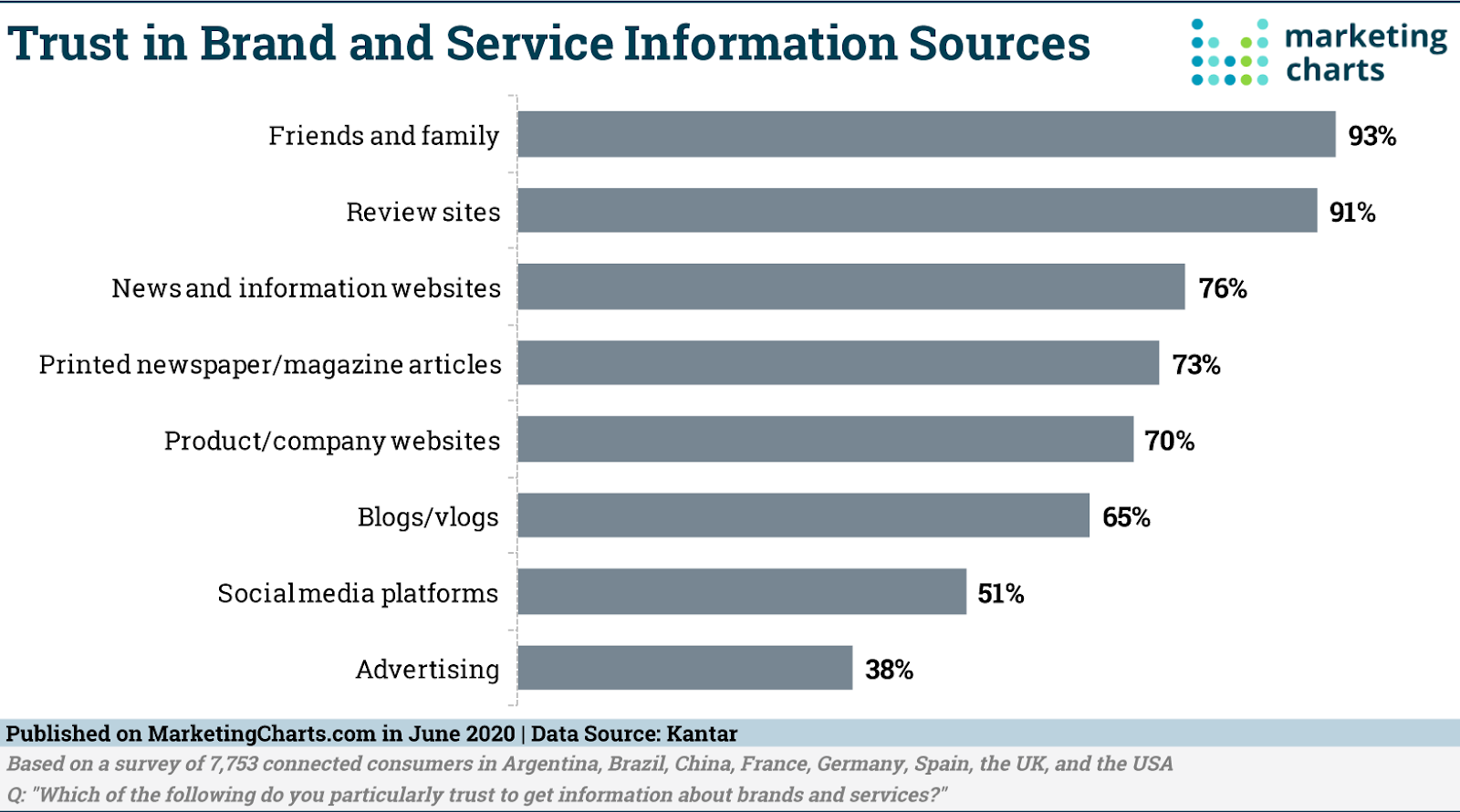
That confirms what most of us already intuitively feel. We trust our friends not to lead us astray. If they say their experience with a product or company is good, we have no reason to suspect ours will be any different.
And many consumers will start their search for a new product by asking for recommendations from people they trust. For all the work brands do to be more visible to new prospects, a certain portion of your potential customers are skipping the online research stage to go straight to a brand a friend suggested.
2. Referral programs are naturally targeted.
Marketers spend a lot of time trying to figure out how to reach their target audience where they are.
Chances are, a lot of the people in your target audience are hanging out with other people in your target audience. Each new customer your marketing earns isn’t just a win for their own sake, they also potentially give you a way in to reaching their contacts. And since most people hang out with others that have similar likes and interests to them, their contacts will typically be other people in your target market.
3. When referral marketing works, it’s exponential.
This might be the best thing about customer referral programs. All that hard work you did to attract one customer with ads, SEO (search engine optimization), and content marketing doesn’t just pay off in them buying the product. When they see that you have a referral program that rewards them for spreading the word, they’ll tell all their friends.
If even just a few of those friends decide to give you a try, love the product, and respond the same way to your referral program, then you have several new customers promoting your product to all their friends. Your reach will grow and grow.
How to Start a Customer Referral Program
In order to get a customer referral program going, there are a few key steps you need to take.
1. Start with a strategy.
Before you start working out the details of your customer referral program, take some time to clarify what you hope to achieve. You’ll get more out of your program if you put careful thought into how to build it and base your choices on clear goals.
In this step, consider who your audience is, what their habits are, and what drives them.
For instance, you’d use a different approach for a referral program targeting middle aged moms most likely to make recommendations to friends one on one than for teenagers that spend a lot of time on social media.
Look to all the research and data you have now about your target audience and their behavior. Do your customers tend to be discount driven? Or do they opt for luxury products because they like feeling special? Understanding what they respond to will help you craft the right kind of referral program to get results.
2. Determine your offer.
Most referral programs are based on providing something to customers in return for spreading the word about your product. If you want to get results, making it worth your customers’ while to talk you up will both increase their likelihood of sharing a recommendation with their friends, and also earn goodwill that inspires more loyalty toward your brand.
The right reward is an important part of building a successful referral program. Consider what you can offer that will incentivize your customers to participate.
Ask a few questions to help you choose the right option:
- What drives your customers to purchase?
- Is your business prone to repeat purchases, or do you sell big ticket items people only buy occasionally?
- Will customers respond more to monetary rewards, or non-monetary goodies?
- What can you reasonably afford to provide (without it cutting too much into profits)?
- What offer will be good enough to inspire people to take action? (If you sell products that cost over $100, $5 off probably won’t get you very far, for instance).
- Should you put limitations on the offer? For example, can customers refer as many friends as they want and keep getting rewards, or will it only apply up to a set number?
If you sell the kind of product that inspires a lot of repeat customers, a discount on a future purchase benefits both of you. If you sell the kind of big-ticket item a person’s not likely to buy again for a while, then something like a gift card or a discount at a partner business may make more sense.
For customers that are driven by deals and savings, offering discounts or money back makes a lot of sense. But for those who value feeling special or acquiring nice things, an exclusive gift item or the chance to join a VIP program that brings special rewards may be more enticing. This is why understanding your audience is key before you take the step of choosing your offer.
In addition to rewarding the customer that sends referrals your way, also plan on offering something to incentivize their friends and followers to take the step of signing up. Offer a discount, a longer trial, or something else that makes it a better value for them to use their friend’s referral link.
In most cases, the offer you provide to the referred will be similar to what you provide the referrer. They’re likely to be in similar audience categories, and thus inspired by the same kind of incentives.
3. Pick your software.
In order to successfully pull off a referral program, you need a way to track referrals and make sure customers receive the promised rewards. For most businesses, investing in referral marketing software will be important in managing that.
Why to Invest in Referral Software
Referral software enables you to organize and streamline the process of promoting your referral program and providing customers with what they need to participate. It tracks when new customers come from a referral link or code, and automates the process of ensuring that both the new customer and the person that referred them get their rewards.
And referral software offers something else crucial: analytics. You can track how successful your program is, and find ways to improve your rates of success based on the data you collect. That’s much harder to pull off manually.
Top Referral Software Options
The market for software that enables referral programs is large, with a number of products that are designed for particular industries or business types. A few of the main choices to consider include:
- Referral Rock – Referral Rock is a popular option that includes features that make it easy for customers to promote your products, automation features to simplify the work involved, and reward fulfillment features so you always make sure your customers get their offer.
- ReferralCandy – ReferralCandy is designed for eCommerce brands. The product automates reward fulfillment and provides detailed analytics to help you identify your top customer advocates and improve your program over time.
- Ambassador – Ambassador’s referral marketing software offers features to help you promote your program and track customer response across different channels. Like the others, it provides the option to automate providing rewards to customers, to simplify the work involved.
- Friendbuy: Friendbuy helps businesses create streamlined referral processes. You can use pre-built templates for your promotions, automate reward fulfillment, and perform A/B testing to gain data on what offers and messaging work best.
- Genius Referrals – Genius Referrals provides sharing tools to make it easy for your customers to promote your products to friends, enables different rewards you can provide, and supplies analytics to help you track your progress.
- Hello Referrals – Hello Referrals is a product primarily designed for business groups and associations. It’s web-based and collaborative, designed to help a business network send each other leads and keep track as they do so.
- MentionMe – MentionMe combines features that encourage referrals with those that help build customer loyalty. The software is designed to work across a number of different industries and will help businesses easily calculate the new revenue generated from referrals and repeat business.
Take some time to review your options and get some quotes for those that look like the best fit. How much work you have to put into the process and how good of an experience your customers have will have a lot to do with the type of software you use.
4. Develop your marketing materials.
Your program won’t get far unless your customers learn it exists and are convinced it’s worth it to them to get involved. For a referral program to work effectively, you want to think about marketing it in a similar way to how you market your products.
A solid marketing plan for a customer referral program will involve developing an array of marketing materials. That may include:
- Emails that promote the program and make clear to customers the benefits of participating.
- Website copy that includes strong calls to action (CTAs) to drive sign ups.
- Landing pages on your website that tout the reasons to participate in the referral program and what customers get out of it.
- Pre-written email and social copy that makes it easy for customers to share information about your products with their friends and followers without doing much work.
The more you do to make customers aware of your referral program and why it pays to join, the more results you’ll see from it.
7 Best Practices for Running a Successful Customer Referral Program
Like most things worth doing, a referral program takes work. To make sure your work pays off, follow a few main best practices that will help you achieve success.
1. Make sure your product is good enough.
A referral program only works if you have customers that like your product enough to recommend it to others. Make sure you’re practicing quality control and paying close attention to any feedback customers provide. Customers aren’t going to promote something they don’t believe in, so make sure you aren’t only converting customers, but that what you’re selling is creating enthusiastic customers that genuinely love your products.
2. Prioritize the customer experience.
A good product matters, but making sure customers have a good experience with your brand from the first moment they hear about you through their entire time as a customer is just as important. If a product gets lost in the mail or something on your website doesn’t work right, how are you equipped to handle it? Do you have an amazing customer service team in place that can make sure any issues a customer experiences are handled effectively enough that they come away praising you?
To make sure you’re providing a good customer experience, regularly use customer surveys and interviews to collect feedback. This is worth doing before you set up a referral program to find any issues with how your processes are set up now, but also worth repeating after you launch the program to check in on how customers feel about it.
3. Commit to promoting your referral program.
Anyone who buys a product from you has the potential to be a valued member of your referral program. Make sure you take every opportunity you can (without becoming a nuisance) to let your customers know about the program and urge them to get involved.
Rover regularly emails their current sitters urging them to recommend the service to other sitters in exchange for gift cards and/or the ability to be entered into a contest. This periodic reminder, coupled with an attractive incentive, makes current sitters that much more likely to mention Rover when they encounter friends likely to be a good fit for the service.
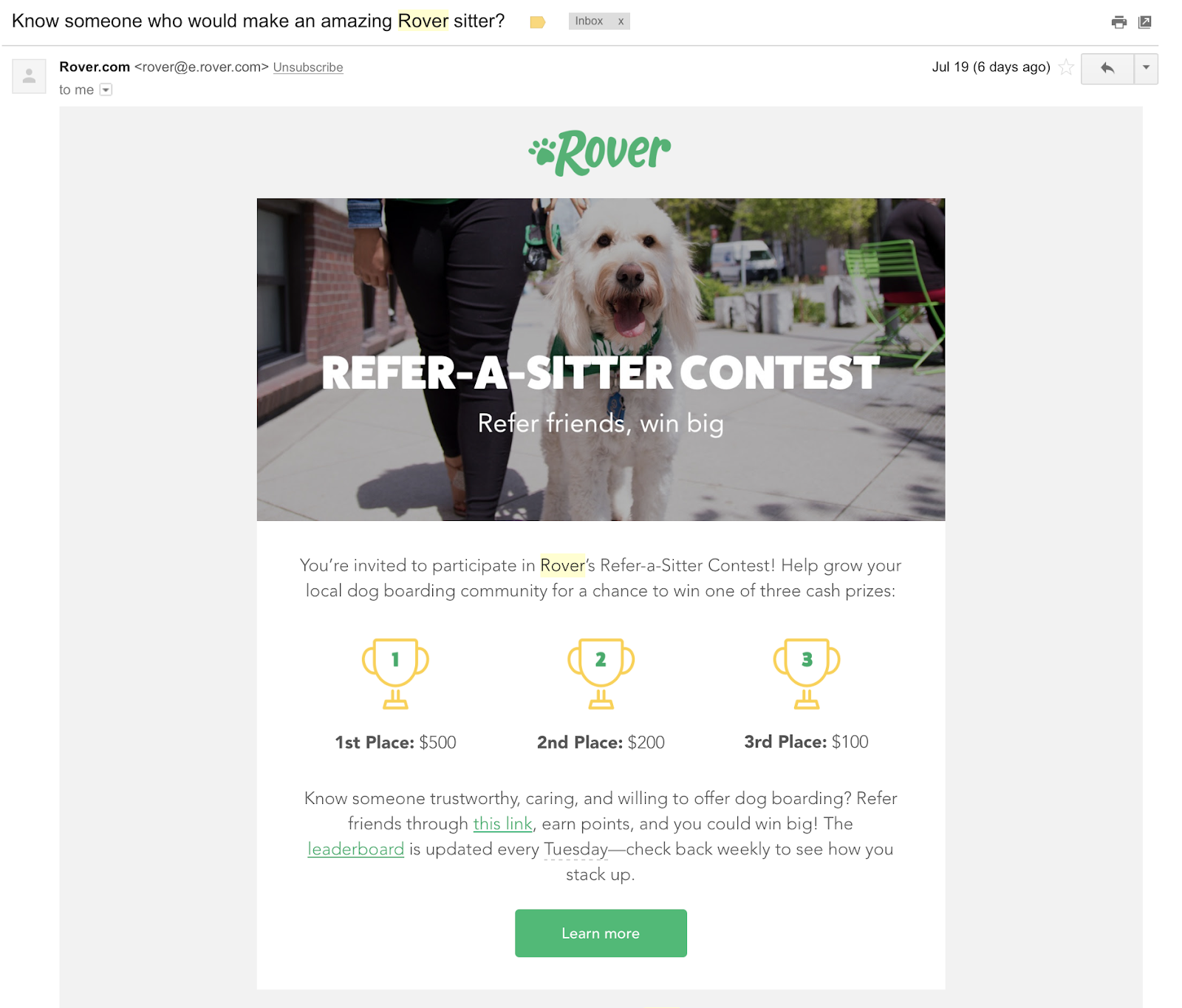
In addition to emails, hit customers with a reminder every time they come to your website. For example, every time a customer visits the Naturebox website, they see the promise of FREE SNACKS displayed in orange in the top menu. That menu item leads to a page touting their referral program. That means any time someone’s browsing the site hungrily, they get a reminder of how easy it is to save money by looping their friends in on the deal.
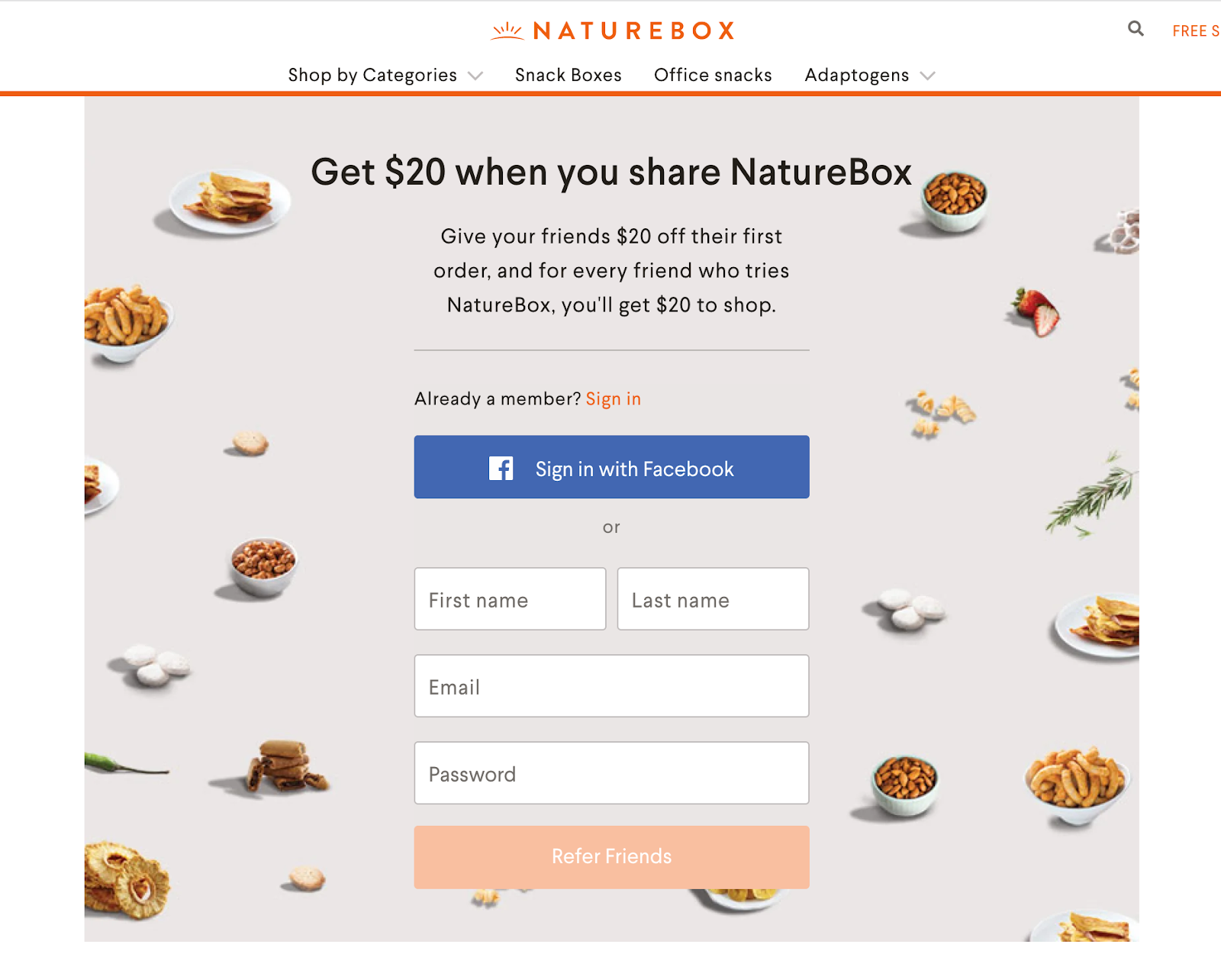
4. Make sure the reward is worth it.
Your customer referral program isn’t likely to go far if you’re not offering something people will want – on both ends of the deal. Gift cards, discounts, and credits are a pretty tried and true method – people like free money. And promising customers discounts on a future order for referring a friend makes them more likely to spend more money with you later.
But you can find other ways to incentivize people as well. For example, Dropbox offers free storage to people who participate in their referral program.
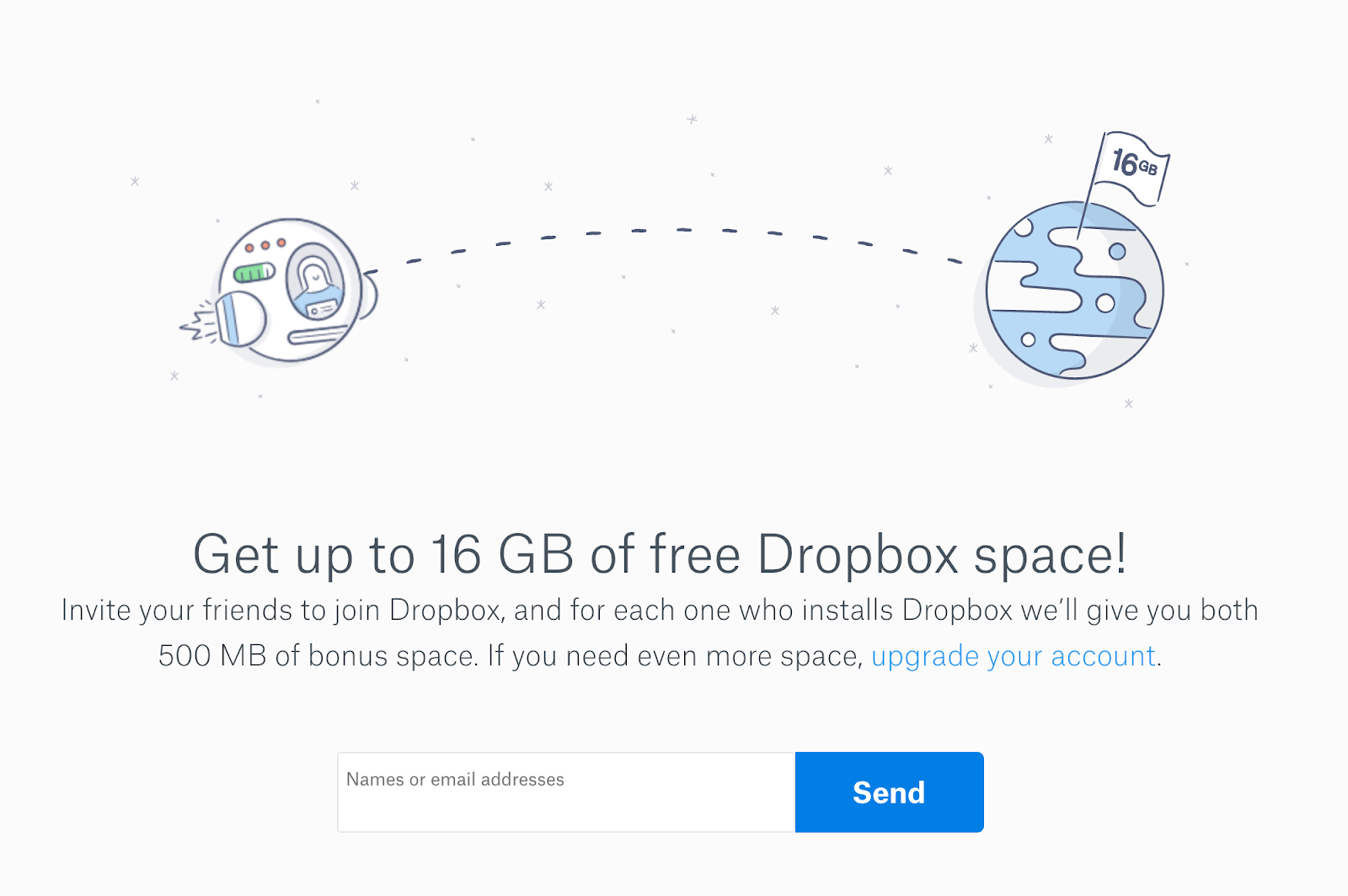
And Adagio includes recommendations as part of their rewards program, so customers can earn points they can cash in later (hello, gamification).
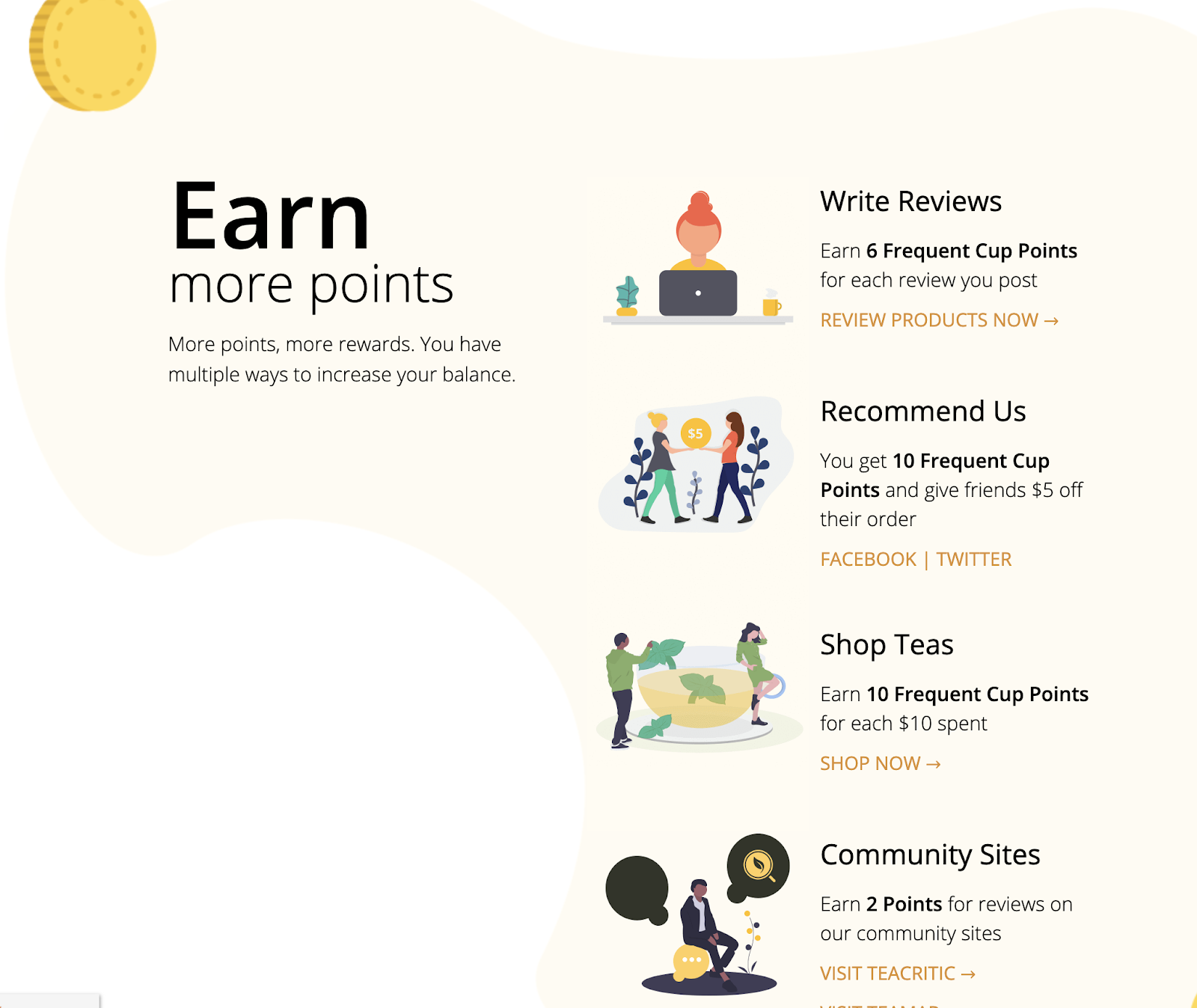
5. Make it easy for customers to share.
People are more likely to do the thing you want them to (in this case, share their referral link) if you remove all friction and make it totally painless.
To that effect, Rover provides pre-filled copy for email, Twitter, and Facebook that people can use if they don’t want to bother writing their own message. You’d be surprised how many people are more likely to take this step if you reduce the amount of work involved, even by a few seconds worth of effort.
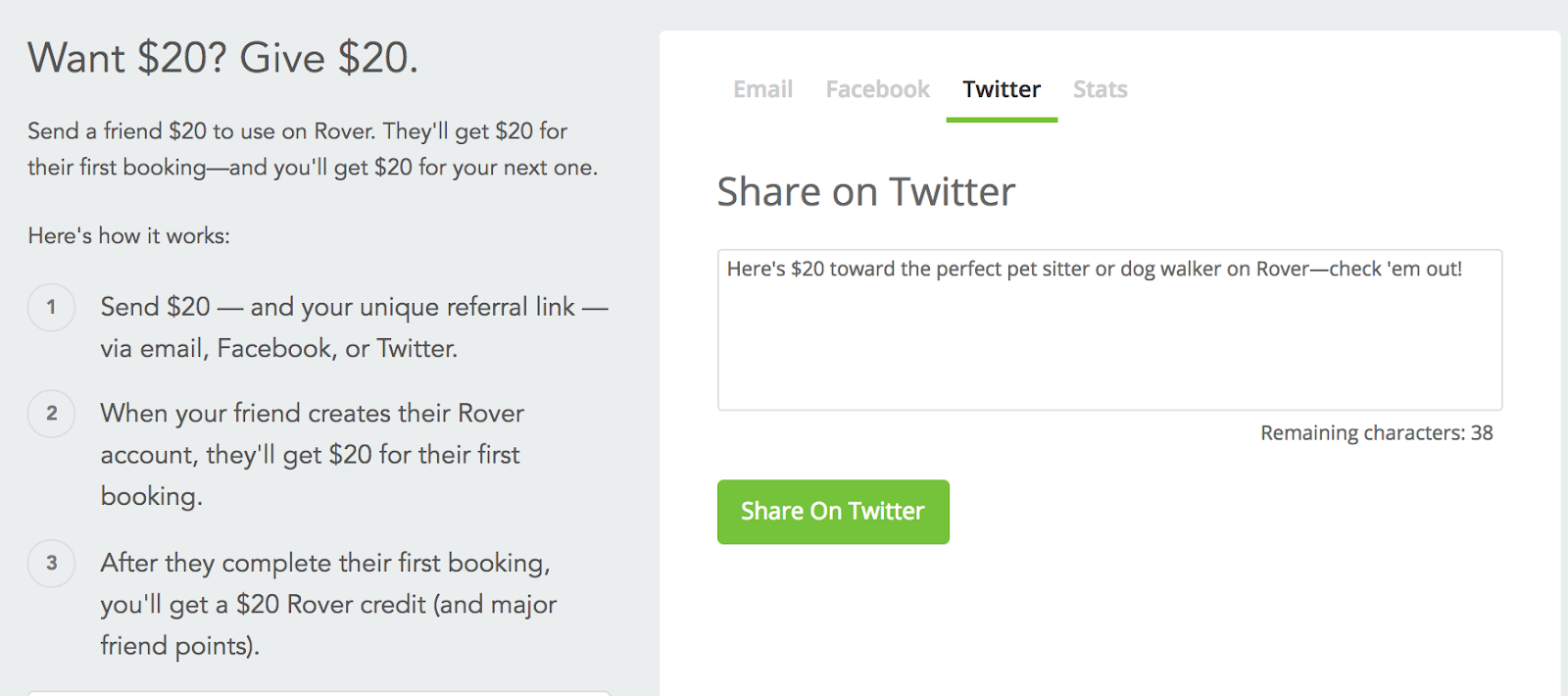
Create some templated copy for different channels—social media and email in particular—that customers can use with a simple click. That brings the benefit of knowing many customers will share the messaging your marketing team worked to get just right. And it makes it extremely easy for customers to do their part.
Most referral software products will help you set this part up. Once you’ve filled in the copy for each channel, customers can send it out with the click of a button.
6. Make the reward easy to claim.
The customers that refer their friends are some of your most valuable customers. You want to keep them happy so they keep spreading the word about you. Don’t make them jump through any hoops to claim the reward they’ve earned. Make it automatic.
When someone comes to you through a customer’s referral link, have it set up so your customer automatically receives the discount, credit, gift card or other reward you’ve promised as soon as possible. If it’s an easy and rewarding experience for them, there’s a good chance they’ll keep it up and send more people your way.
This is another step that referral software helps with. Most referral products automate the process of reward fulfillment. If you want to create a simple and painless process for your customers, then make sure to choose a referral marketing product that makes that possible.
7. Pay attention to results.
No matter how well you plan out your referral marketing program to start, you’ll have room for improvement. As you go, pay attention to what your analytics tell you. You’ll gain insights into which customers most frequently refer people, what messaging gets the best results, and what channels are the most effective for driving referrals your way.
The more you learn, the more you can tweak the details of your program to improve results over time. Take advantage of the information you gain to improve both your referral program, and your larger marketing efforts. Knowing which customers are the most enthusiastic about your products gives you insights into your most valuable audience. That can lead to stronger personas and better targeting for your overall campaigns.
Conclusion
The customers that love you are more valuable to your company than anything else. They can make and break your success.
Customer referral programs give you a way to actively nurture those connections and gain new customers at the same time. When done well, they’re beneficial to all involved and can be a boon to both your customer relationships and your bottom line.




![Yes, B2B Websites Can Use Personalization Too [Here’s How]](https://mdvirtue.com/wp-content/uploads/2022/02/Yes-B2B-Websites-Can-Use-Personalization-Too-Heres-How-400x250.jpeg)

0 Comments